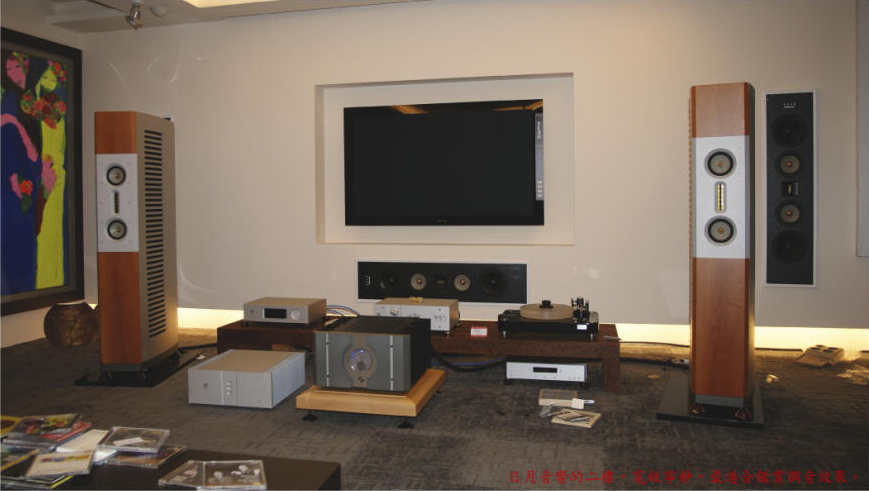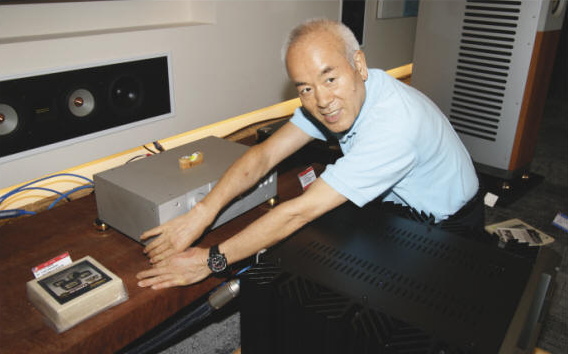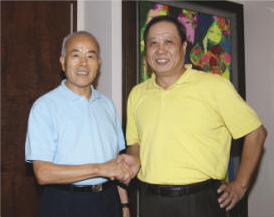Kazuo Kiuchi’s Sound-tuning at Sun-moon AV Co.
A Few Tricks that Make a World of Difference!
By/Hong-ching Pu
 |
| The second floor of Sun-moon is broad and quiet, making it perfect for evaluating stereo equipment. |
Located near the Breeze Plaza, Sun-moon Audio Visual Co. is one of the most important hi-end stereo shops in Taipei City. Sun-moon offers all types of expensive stereo equipment for customers to try them out. Mr. Hsui-de Chu, the owner of Sun-moon, knows the things he sells as well as how to arrange them, but he seldom recommends sound-tuning tools such as feet to customers. He had always believed that hi-end stereos are expensive enough; wouldn’t it make them think that the equipment isn’t good enough if they were recommended to use feet? Perhaps they would even think the shop is trying to rip them off!
In fact, it is normal for hi-end stereo stores to have this kind of concern. It is difficult to promote tuning feet to customers, especially those who are new to the world of audio, that using the right feet is actually the fastest short-cut to achieving premium sound.
Having this in mind, I talked Ms. Chang of Billion Music and Kiuchi into paying Sun-moon a visit a month ago when the Yuanshan Stereo Exhibition ended. Lawyer Tsai, another audiophile, also joined our trip. The purpose of our trip to Sun-moon was simple: to let Mr. Chu experience the superior performance of Kiuchi’s feet and see if he would recommend them to his customers.
The Equipment Could’ve Performed Better
Why Not Let them?
According to Kiuchi, many types of stereo equipment actually have great performance and design. However, stereo is a type of equipment that generates sound through vibration, thus any vibration within a set of stereo would affect the sound. If the equipment is placed on an inappropriate desktop or floor, the vibration from external sources often affects the resonance of sound, distorting the performance and sound quality that the equipment should be offering. To address this, it is necessary to minimize the external influences or to use resonated vibration to make the vibrations working on the stereo harmonic, making the factors working with the sound instead of against it. This is when many of Kiuchi’s Harmonix products come into play.
 |
| Different feet work differently. Play with them and see what the best way to combine them is. |
With this persuasive logic, Chu welcomed Kiuchi’s visit and was willing to experience the master’s sound-tuning skills.
Therefore, a week after the conclusion of the stereo exhibition, Kiuchi visited Sun-moon twice and performed tuning on Burmester speakers, Ayre pre-amps, Ayre CD players, and Ayre and Pass amps, where were put on display on 2F of Sun-moon.
According to Kuchi, the tuning of sound has to begin with speakers, then with the amp, and then other equipment. He didn’t explain why it had to be done in this order, but he did only use a few sets of feet to make the sound generated from the combination of Burmester speakers and Ayre amps come alive and clearer.
In fact, prior to the tuning, this set of equipment at Sun-moon had already performed quite well. The details are rich, the sound is clear – though a little thin, but I think it was the characteristic of Burmester speakers, given their German heritage, and Ayre’s focus on generating ethereal sound.
Appropriate feet Can Compensate for the Essential Elements Lacking in Sound
After listening to the result for a while, Kiuchi said more could be done to improve the volume of the low frequency and make the sound more alive. He put TU-220 tuning feet underneath the speakers and moved the speakers a few inches closer to us.
This small trick actually instantly made the details and acoustic of the same music much better. The low frequency became clearer, the mid-range became warmer, and the rhythm became more distinct. What was more special was that the texture of the high frequency got improved and had richer musical affects. To my understanding, this kind of multi-dimensional improvement is almost impossible to achieve by using feet that are made of entirely metal or wood. No wonder many feet of Kiuchi’s are metal-wood combinations, and the purpose should be to generate a balanced music.
 |
| Kiuchi understands his products well and knows what sets of feet to work with in what situations. |
Afterwards, Kiuchi added TU-666 and TU-606 tuning feet to the Ayre CD player and pre-amp respectively. The sound didn’t only become more alive but also very smooth and harmonic, and you won’t get tired of listening to the sound they generate even if you do so for an entire day. Accardo’s Paganini violin album, “Diabolus in Music,” originally had a rather sharp texture of sound; with Kiuchi’s feet, however, the sound not only became cleaner but also very beautiful and extensive, and it no longer stings your ears if when you turn up the volume. With this kind of result, Chu, Lawyer Tsai, and I all thought that the sound was good enough and there was no need to further enhance it.
Common Shelves May Deteriorate the Sound Quality
However, Kiuchi continued to carefully examine whether each piece of equipment had room for improvement. He then determined that the wood board under the amp could affect the Harmonix tuning feet and even hinder the sound quality. He then proposed to have the board removed and keeping Harmonix RF-999 under the amp, while adding TU-201 to replace the original board.
The same music was played again, and the result was an instant surprise! The sound not only became more vivid but with better resolution and image. The music had so much flesh and blood and life, sounded more touching, and also reinforced each musical instrument’s characteristics, making everyone on the scene excited.
 |
||
| The enthusiastic Chu and Lawyer Tsai push the speakers around despite their ages, and this shows you the fun of being an audiophile! | The sound improvement puts a smile in everyone’s face! | Kiuchi encourages using different feet at the same time – if you come with a big enough wallet. |
The difference before and after tuning was so great that Mr. Chu didn’t want to remove the feet anymore. He was obviously surprised how the sound changed so much with a little touch-up from Kiuchi. In fact, I have always remembered Burmester speakers as sounding like “speakers” with protruding high and low frequencies at the two ends. It was the first time for me to hear such smooth sound from these speakers.
Billion Music didn’t bring all the feet to Sun-moon Audio Visual Co., thus Kiuchi performed tuning without having many tools to work with. If there were more feet available, I am sure Kiuchi would have done an even better job. That is why by judging Kiuchi’s facial expression, I could tell that he wasn’t too satisfied with the result, but there was little he could do.
Each type of feet Kiuchi has is a work of sophistication and lengthy trial-and-error. Of course, Kiuchi also knows each feet’s characteristic from inside out, and that is why he always knows what feet to use in what situations.
In the past few months, I have tried quite a few feet provided by Billion Music. For the sake of writing articles on them, however, I only used one line-up at a time and never mixed them together. During Kiuchi’s exhibition in Sun-moon Co., I have learned that if we use Harmonix tuning feet flexibly, you will be surprised by how much the sound of a stereo can be improved. What is more special is that even if three or four sets of Kiuchi’s feet are used at the same time, the sound still maintains its balance but with better harmony and music output. What is especially valuable about the products is how they make musical performance come alive – feeling as if a singer or violinist is performing live right in front of you is certainly unforgettable and irresistible.
Kiuchi only showed a few tricks yet the sound improved so much; if he had an entire day complete with other types of feet, the sound should be able to perform even better.
Significant Results with Only One Set of feet
I think Mr. Chu, the boss of Sun-moon, has fallen in love with Harmonix products after experiencing this demonstration of tuning with Harmonix products.
 |
| The love for music brings two people from two different countries together. Now that Chu finally understood what Kiuchi had up in his sleeves, he couldn’t stop praising Harmonix tuning feet for their values. |
Since Kiuchi’s sound-tuning feet do not come cheap, it is difficult for common folks like us to use 5 or 6 sets of different types of feet at the same time like what was done in Sun-moon. Rest assured, however, that another demonstration with a set of stereo in Sun-moon has shown that just by putting four 606 tuning feet under an Ayre CD player, the improvement of the sound was already surprising. Not only the sound became clearer, the vocalist’s strength and low frequency also became more powerful. It is really hard to understand why a set of 606 tuning feet would give such a significant result.
This kind of result proves Kiuchi right: any hi-end stereo equipment can still be improved using Harmonix tuning feet since most furniture, desktops, shelves, and stereo racks are not designed based on the principle of sound harmony and resonance. Inharmonic vibrations would only deteriorate the quality of sound, and Harmonix sound-tuning tools make the sound vibrate in a balanced fashion and restores harmony.
I had a few doubts about this theory of Kiuchi’s before. After the sound-tuning experience at Sun-moon, I have realized that Kiuchi’s sound-tuning skills are truly exceptional as they passed the test with flying colors. Kiuchi certainly lives up to his reputation as the “master of sound-tuning!”
[close]